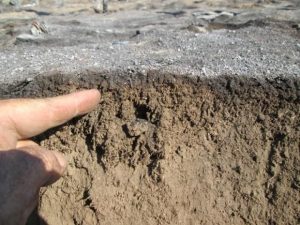You can save work and have better garden soil if you stop tilling and digging—really. We’ve long had the idea that deep and frequent digging was the way to gardening success, but such hard labors are destructive to the innumerable microorganisms toiling within rich topsoil.
Superior soil, it turns out, is teeming with invisible life. A mere teaspoon can contain a billion bacteria, several yards of fungal hyphae (filaments), thousands of protozoa, and perhaps a few dozen nematodes. Sure, there are some bad actors in the bunch, but like the insect world above ground, it’s eat and be eaten by their hungry neighbors.
WHO’S WHO IN THE SOIL:
Bacteria decompose and recycle green materials like grass clippings and kitchen wastes. They break down toxins and pollutants and even help clean up oil and gasoline spills. Other bacteria convert nitrogen from the atmosphere to a form useful to plants.
Fungi attack tougher materials. Many release enzymes to break down cellulose in wood and in the hard shells of insects and animal bones. Some fungi absorb nutrients like phosphorous, zinc and iron, and transport them to plants. They trap nematodes and secrete an enzyme to absorb the nutrients from the nematodes.
Nematodes may consume bacteria and fungi while helping promote a balance of soil life. Other soil and water organisms include algae, slime molds, protozoa and amoebae, many having symbiotic relationships that contribute to soil health.
Next are the countless insects and spiders either in or on the soil. Those living on the soil are shredders that chew up leaves and other organic material thus exposing a greater surface area for bacteria and fungi to breakdown. Other insects live below the soil’s surface, contributing their own waste products, mixing and aerating as they go.
Earthworms are master shredders and eating machines feasting on bacteria and other microorganisms. When devoured, these organisms release water and nutrients to nourish plants and yet other microorganisms. Since earthworms can burrow, sometimes several feet deep, they aerate and add water-holding abilities. Earthworm waste, or vermicastings, is a nourishing soil amendment.
BUILDING YOUR HEALTHY SOIL
Since most of a plant’s feeder roots lie near the surface where biological activity and aeration are greatest, tilling is counter-productive. All that soil churning–whether from spade, tiller, or worse, bulldozer–disrupts helpful organisms and crushes their tunnels.
Tilling also brings weed seeds, which have lain dormant for lack of light and water, to the surface where they enthusiastically germinate.
If you are working with heavy clay or in a compacted construction site, initially dig or till liberal quantities of organic material into the soil. If you must till further, do so at varying depths to avoid creating a hardened layer called “plowpan.” Place stepping stones through planting beds to prevent additional damage.
Each year add a new layer of compost and more mulch on top of the soil. Remove weeds by pulling or chopping with a sharp hoe. When planting, make holes or a trench just deep enough for seeds or young seedlings. Use only organic or slow-release fertilizer, or none at all.
You will then have literally laid the groundwork for soil life to improve drainage and boost root access to water and oxygen. Your soil will be enriched and the acid base balance (pH ratio) will be regulated along with an enhanced defense against soil diseases. You will greatly lessen need for commercial fertilizers, save water, reduce runoff, and decrease erosion.
Mother Nature knows best. It’s easier to build fertile soil her eco-friendly way.
Vera Strader is a University of California Cooperative Extension Master Gardener of Tuolumne County who spends her time not tilling her garden.


